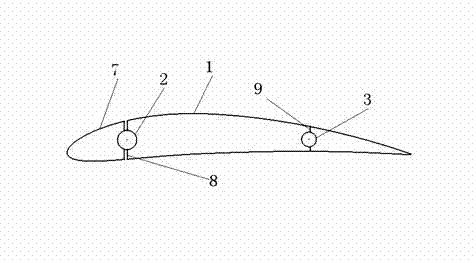Airfoil transformation mechanism of submarine aircraft
A diving aircraft and wing technology is applied in the field of the submersible aircraft wing changing mechanism, which can solve the problems such as unfavorable underwater navigation of the diving aircraft, low skin stiffness and air velocity pressure that cannot meet the flying requirements of the diving aircraft, and large resistance, and the like. The effect of large resistance, increase of maximum speed pressure, and reduction of water-facing area
- Summary
- Abstract
- Description
- Claims
- Application Information
AI Technical Summary
Problems solved by technology
Method used
Image
Examples
Embodiment Construction
[0014] Among the figure 1 is the second half of the wing rib fixed on the front and rear spars by two front and rear rotating shafts, which can rotate relative to the spar in the horizontal plane by the rotating shafts.
[0015] Figure 2 is the front main beam of the wing fixed on the fuselage. There is a z-axis rotating shaft at the wing heel where it intersects with the fuselage to divide the wing beam into inner and outer parts. The outer part of the wing beam can rotate around the shaft 90 degrees, the spar is parallel to the longitudinal axis of the fuselage after the rotation is completed.
[0016] 3 in the figure is the rear main beam of the wing fixed on the fuselage. There is a z-axis direction rotating shaft at the wing heel where it intersects with the fuselage and divides the wing beam into two sections, the outer section of the wing spar and the fuselage. The wing front spar can rotate 90 degrees around the rotating shaft together, and the rear spar is parallel to...
PUM
 Login to View More
Login to View More Abstract
Description
Claims
Application Information
 Login to View More
Login to View More - R&D
- Intellectual Property
- Life Sciences
- Materials
- Tech Scout
- Unparalleled Data Quality
- Higher Quality Content
- 60% Fewer Hallucinations
Browse by: Latest US Patents, China's latest patents, Technical Efficacy Thesaurus, Application Domain, Technology Topic, Popular Technical Reports.
© 2025 PatSnap. All rights reserved.Legal|Privacy policy|Modern Slavery Act Transparency Statement|Sitemap|About US| Contact US: help@patsnap.com



